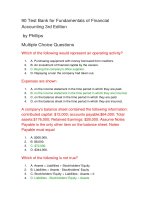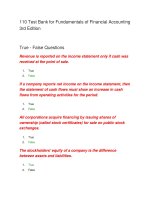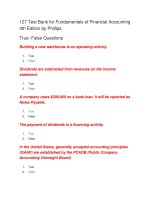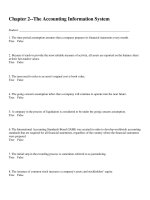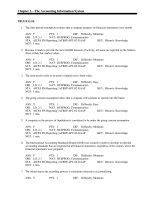Fundamentals of financial accounting 5th edition solution manual by fred phillips robert libby patricia libby
Bạn đang xem bản rút gọn của tài liệu. Xem và tải ngay bản đầy đủ của tài liệu tại đây (823.33 KB, 47 trang )
Fundamentals Of Financial Accounting 5th Edition Solution
Manual by Fred Phillips, Robert Libby, Patricia Libby
Chapter 1
Business Decisions and Financial Accounting
ANSWERS TO QUESTIONS
1.
Accounting is a system of analyzing, recording, and summarizing the results of a
business’s activities and then reporting them to decision makers.
2. An advantage of operating as a sole proprietorship, rather than a corporation, is that
it is easy to establish. Another advantage is that income from a sole proprietorship
is taxed only once in the hands of the individual proprietor (income from a
corporation is taxed in the corporation and then again in the hands of the individual
shareholder). A disadvantage of operating as a sole proprietorship, rather than a
corporation, is that the individual proprietor can be held responsible for the debts of
the business.
3. Financial accounting focuses on preparing and using the financial statements that
are made available to owners and external users such as customers, creditors, and
potential investors who are interested in reading them. Managerial accounting
focuses on other accounting reports that are not released to the general public, but
instead are prepared for internal decision making and used by employees,
supervisors, and managers who run the company.
4. Financial reports are used by both internal and external groups and individuals. The
internal groups are comprised of the various managers of the business. The
external groups include investors, creditors, governmental agencies, other
interested parties, and the public at large.
Fundamentals of Financial Accounting, 5/e
1-1
5. The business itself, not the individual stockholders who own the business, is viewed
as owning the assets and owing the liabilities on its balance sheet. A business’s
balance sheet includes the assets, liabilities, and stockholders’ equity of only that
business and not the personal assets, liabilities, and equity of the stockholders.
The financial statements of a company show the results of the business activities of
only that company.
Fundamentals of Financial Accounting, 5/e
1-2
6.
(a) Operating – These activities are directly related to earning profits. They include
buying supplies, making products, serving customers, cleaning the premises,
advertising, renting a building, repairing equipment, and obtaining insurance
coverage.
(b) Investing – These activities involve buying and selling productive resources with
long lives (such as buildings, land, equipment, and tools), purchasing investments,
and lending to others.
(c) Financing – Any borrowing from banks, repaying bank loans, receiving
contributions from stockholders, or paying dividends to stockholders are considered
financing activities.
7.
The heading of each of the four primary financial statements should include the
following:
(a) Name of the business
(b) Name of the statement
(c) Date of the statement, or the period of time that the statement covers
8. (a) The purpose of the balance sheet is to report the financial position (assets,
liabilities and stockholders’ equity) of a business at a point in time.
(b) The purpose of the income statement is to present information about the
revenues, expenses, and net income of a business for a specified period of time.
(c) The statement of retained earnings reports the way that net income and the
distribution of dividends affected the financial position of the company during the
period.
(d) The purpose of the statement of cash flows is to summarize how a business’s
operating, investing, and financing activities caused its cash balance to change
over a particular period of time.
9. The income statement, statement of retained earnings, and statement of cash flows
would be dated “For the Year Ended December 31, 2015,” because they report the
inflows and outflows of resources over a period of time. In contrast, the balance
sheet would be dated “At December 31, 2015,” because it represents the assets,
liabilities and stockholders’ equity at a specific date.
10. Net income is the excess of total revenues over total expenses. A net loss occurs if
total expenses exceed total revenues.
11. The accounting equation for the balance sheet is: Assets = Liabilities +
Stockholders’ Equity. Assets are the economic resources controlled by the
company. Liabilities are amounts owed by the business. Stockholders’ equity is
the owners’ claims to the business. It includes amounts contributed to the business
(by investors through purchasing the company’s stock) and the amounts earned
and accumulated through profitable business operations.
Fundamentals of Financial Accounting, 5/e
1-3
12. The equation for the income statement is Revenues – Expenses = Net Income.
Revenues are increases in a company’s resources, arising primarily from its
operating activities. Expenses are decreases in a company’s resources, arising
primarily from its operating activities. Net Income is equal to revenues minus
expenses. (If expenses are greater than revenues, the company has a Net Loss.)
13. The equation for the statement of retained earnings is: Beginning Retained
Earnings + Net Income - Dividends = Ending Retained Earnings. It begins with
beginning-of-the-year retained earnings which is the prior year’s ending retained
earnings reported on the prior year’s balance sheet. The current year's net income
reported on the income statement is added and the current year's dividends are
subtracted from this amount. The ending retained earnings amount is reported on
the end-of-year balance sheet.
14. The equation for the statement of cash flows is: Cash flows from operating activities
+ Cash flows from investing activities + Cash flows from financing activities =
Change in cash for the period. Change in cash for the period + Beginning cash
balance = Ending cash balance. The net cash flows for the period represent the
increase or decrease in cash that occurred during the period. Cash flows from
operating activities are cash flows directly related to earning income (normal
business activity). Cash flows from investing activities include cash flows that are
related to the acquisition or sale of the company’s long-term assets. Cash flows
from financing activities are directly related to the financing of the company.
15. Currently, the Financial Accounting Standards Board (FASB) is given the primary
responsibility for setting the detailed rules that become Generally Accepted
Accounting Principles (GAAP) in the United States. (Internationally, the
International Accounting Standards Board (IASB) has the responsibility for setting
accounting rules known as International Financial Reporting Standards (IFRS).)
16. The main goal of accounting rules is to ensure that companies produce useful
financial information for present and potential investors, lenders, and other creditors
in making decisions in their capacity as capital providers. Financial information
must show relevance and faithful representation, as well as be comparable,
verifiable, timely, and understandable.
Fundamentals of Financial Accounting, 5/e
1-4
17. An ethical dilemma is a situation where following one moral principle would result in
violating another. Three steps that should be considered when evaluating ethical
dilemmas are:
(a) Identify who will benefit from the situation (often, the manager or employee) and
how others will be harmed (other employees, the company’s reputation, owners,
creditors, and the public in general).
(b) Identify the alternative courses of action.
(c) Choose the alternative that is the most ethical – that which you would be proud
to have reported in the news media. Often, there is no one right answer and hard
choices will need to be made. Following strong ethical practices is a key part of
ensuring good financial reporting by businesses of all sizes.
18. Accounting frauds and cases involving academic dishonesty are similar in many
respects. Both involve deceiving others in an attempt to influence their actions or
decisions, often resulting in temporary personal gain for the deceiver. For example,
when an accounting fraud is committed, financial statement users may be misled
into making decisions they wouldn’t have made had the fraud not occurred (e.g.,
creditors might loan money to the company, investors might invest in the company,
or stockholders might reward top managers with big bonuses). When academic
dishonesty is committed, instructors might assign a higher grade than is warranted
by the student’s individual contribution. Another similarity is that, as a consequence
of the deception, innocent bystanders may be adversely affected by fraud and
academic dishonesty. Fraud may require the company to charge higher prices to
customers to cover costs incurred as a result of the fraud. Academic dishonesty
may lead to stricter grading standards, with significant deductions taken for
inadequate documentation of sources referenced. A final similarity is that if fraud
and academic dishonesty are ultimately uncovered, both are likely to lead to
adverse long-term consequences for the perpetrator. Fraudsters may be fined,
imprisoned, and encounter an abrupt end to their careers. Students who cheat may
be penalized through lower course grades or expulsion, and might find it impossible
to obtain academic references for employment applications.
Fundamentals of Financial Accounting, 5/e
1-5
Authors' Recommended Solution Time
(Time in minutes)
Mini-exercises
No.
1
2
3
4
5
6
7
8
9
10
11
12
13
14
15
16
Time
3
12
12
6
4
6
6
4
4
3
3
6
5
5
4
12
Exercises
No.
1
2
3
4
5
6
7
8
9
10
11
12
Problems
Time
10
10
15
25
25
10
15
10
20
10
3
3
No.
CP1-1
CP1-2
CP1-3
CP1-4
PA1-1
PA1-2
PA1-3
PA1-4
PB1-1
PB1-2
PB1-3
PB1-4
Time
45
10
50
5
45
10
50
5
45
10
50
5
Skills
Development
Cases*
No.
Time
1
20
2
20
3
30
4
30
5
20
6
30
7
45
Continuing Case
No.
1
Time
45
* Due to the nature of cases, it is very difficult to estimate the amount of time students will need to
complete them. As with any open-ended project, it is possible for students to devote a large amount of
time to these assignments. While students often benefit from the extra effort, we find that some become
frustrated by the perceived difficulty of the task. You can reduce student frustration and anxiety by
making your expectations clear, and by offering suggestions (about how to research topics or what
companies to select). The skills developed by these cases are indicated below.
Case Financial Analysis
1
2
3
4
5
6
7
x
x
x
x
x
x
x
Research
Ethical
Reasoning
Critical
Thinking
x
x
x
x
x
Fundamentals of Financial Accounting, 5/e
Technology
Writing
Teamwork
x
x
x
x
x
x
1-6
ANSWERS TO MINI-EXERCISES
M1-1
Abbreviation
Full Designation
(1)
CPA
Certified Public Accountant
(2)
GAAP
Generally Accepted Accounting Principles
(3)
FASB
Financial Accounting Standards Board
(4)
SEC
Securities and Exchange Commission
(5)
IFRS
International Financial Reporting Standards
M1-2
Term or Abbreviation
I
(1) SEC
F
(2) Investing activities
D
(3) Private company
E
(4) Corporation
A
(5) Accounting
C
(6) Partnership
J
(7) FASB
G
(8) Financing activities
B
(9) Unit of measure
L (10) GAAP
K (11) Public company
H (12) Operating activities
Fundamentals of Financial Accounting, 5/e
Definition
A. A system that collects and processes financial
information about an organization and reports that
information to decision makers.
B. Measurement of information about a business in the
monetary unit (dollars or other national currency).
C. An unincorporated business owned by two or more
persons.
D. A company that sells shares of its stock privately and is
not required to release its financial statements to the
public.
E. An incorporated business that issues shares of stock
as evidence of ownership.
F. Buying and selling productive resources with long lives.
G. Transactions with lenders (borrowing and repaying
cash) and stockholders (selling company stock and
paying dividends).
H. Activities directly related to running the business to
earn profit.
I. Securities and Exchange Commission.
J. Financial Accounting Standards Board.
K. A company that has its stock bought and sold by
investors on established stock exchanges .
L. Generally accepted accounting principles.
1-7
M1-3
F
C
E
A
B
H
D
G
(1)
(2)
(3)
(4)
(5)
(6)
(7)
(8)
Term
Relevance
Faithful Representation
Expenses
Separate Entity
Assets
Liabilities
Stockholders’ Equity
Revenues
A.
B.
C.
D.
E.
F.
G.
H.
Definition
The financial reports of a business are assumed
to include the results of only that business’s
activities.
The resources owned by a business.
Financial information that depicts the economic
substance of business activities.
The total amounts invested and reinvested in the
business by its owners.
The costs of business necessary to earn
revenues.
A feature of financial information that allows it to
influence a decision.
Earned by selling goods or services to
customers.
The amounts owed by the business.
M1-4
Cash (Example)
(1) Accounts Payable
(2) Accounts Receivable
(3) Income Tax Expense
(4) Sales Revenue
(5) Notes Payable
(6) Retained Earnings
Statement
B/S
B/S
B/S
I/S
I/S
B/S
B/S
Account Type
A
L
A
E
R
L
SE
M1-5
(1) Accounts Receivable
(2) Sales Revenue
(3) Equipment
(4) Supplies Expense
(5) Cash
(6) Advertising Expense
(7) Accounts Payable
(8) Retained Earnings
Fundamentals of Financial Accounting, 5/e
Statement
B/S
I/S
B/S
I/S
B/S
I/S
B/S
B/S
Account Type
A
R
A
E
A
E
L
SE
1-8
M1-6
(1) Accounts Receivable
(2) Office Expenses
(3) Cash
(4) Equipment
(5) Advertising Expense
(6) Sales Revenue
(7) Notes Payable
(8) Retained Earnings
(9) Accounts Payable
Type
A
E
A
A
E
R
L
SE
L
Statement
B/S
I/S
B/S
B/S
I/S
I/S
B/S
B/S
B/S
M1-7
(1) Accounts Payable
(2) Common Stock
(3) Equipment
(4) Accounts Receivable
(5) Notes Payable
(6) Cash
(7) Retained Earnings
(8) Office Expenses
(9) Sales Revenue
(10) Supplies
Type
L
SE
A
A
L
A
SE
E
R
A
Statement
B/S
B/S
B/S
B/S
B/S
B/S
B/S
I/S
I/S
B/S
M1-8
(1) Dividends
(2) Common Stock
(3) Sales Revenue
(4) Equipment
(5) Cash
(6) Note Payable
(7) Accounts Payable
(8) Retained Earnings, Beginning of Year
Fundamentals of Financial Accounting, 5/e
Type
D
SE
R
A
A
L
L
SE
Statement
SRE
B/S
I/S
B/S
B/S
B/S
B/S
SRE
1-9
M1-9
D
B
D
A
C
B
D
A
(1)
(2)
(3)
(4)
(5)
(6)
(7)
(8)
Element
Cash Flows from Financing Activities
Expenses
Cash Flows from Investing Activities
Assets
Dividends
Revenues
Cash Flows from Operating Activities
Liabilities
A.
B.
C.
D.
Financial Statement
Balance Sheet
Income Statement
Statement of Retained Earnings
Statement of Cash Flows
M1-10
(F)
O
F
(O)
(I)
F
(1) Cash paid for dividends
(2) Cash collected from customers
(3) Cash received when signing a note
(4) Cash paid to employees
(5) Cash paid to purchase equipment
(6) Cash received from issuing stock
M1-11
(I)
O
I
(F)
(O)
F
(1) Cash paid to purchase land
(2) Cash collected from clients
(3) Cash received from selling equipment
(4) Cash paid for dividends
(5) Cash paid to suppliers
(6) Cash received from issuing stock
Fundamentals of Financial Accounting, 5/e
1-10
M1-12
STONE CULTURE CORPORATION
Statement of Retained Earnings
For the Year Ended December 31, 2014
Retained Earnings, January 1, 2014
Add: Net Income
Subtract: Dividends
Retained Earnings, December 31, 2014
$
0
40,000
(15,000)
$ 25,000
STONE CULTURE CORPORATION
Statement of Retained Earnings
For the Year Ended December 31, 2015
Retained Earnings, January 1, 2015
Add: Net Income
Subtract: Dividends
Retained Earnings, December 31, 2015
$ 25,000
45,000
(20,000)
$ 50,000
M1-13
Common Stock
Dividends
Net Income
Retained Earnings, Beginning of Year
Retained Earnings, End of Year
Total Assets
Total Expenses
Total Liabilities
Total Revenues
Fundamentals of Financial Accounting, 5/e
Apple, Inc.
$20
0
(a) 49
104
(b) 153
(c) 256
122
83
171
Google, Inc.
$23
0
(d) 16
38
(e) 54
(f) 99
34
22
50
Intel Corp.
$19
11
(g) 14
30
(h) 33
(i) 85
39
33
53
1-11
M1-14
Common Stock
Dividends
Net Income
Retained Earnings, Beginning of Year
Retained Earnings, End of Year
Total Assets
Total Expenses
Total Liabilities
Total Revenues
Amazin’
Corp.
$5
10
(a) 25
30
(b) 45
(c) 80
75
30
100
Best Tech,
Inc.
$15
5
(d) 20
0
(e) 15
(f) 60
30
30
50
Colossal
Corp.
$100
50
(g) 100
200
(h) 250
(i) 700
200
350
300
M1-15
(a) 100 (b) 20 (c) 3,700. Electronic Arts was profitable because its revenues ($3,800)
were greater than its expenses ($3,700), resulting in the net income of $100 reported on
the income statement.
The above amounts are determined using the various relationships that exist in the
financial statements. Because this exercise excludes two pieces of information from
both the income statement and statement of retained earnings, students must first work
backwards from the balance sheet to the statement of retained earnings to the income
statement. Although not required, the following statements show the given and missing
information. The ?s in the balance sheet are determined from A = L + SE.
Electronic Arts, Inc.
Income Statement
For the Year Ended xxxx
Revenues
$3,800
Expenses
(c)
Net Income (Loss)
(a)
Electronic Arts, Inc.
Statement of Retained Earnings
For the Year Ended xxxx
RE, beginning
$(80)
Net income (loss)
(a)
Dividends
(0)
RE, ending
(b)
Fundamentals of Financial Accounting, 5/e
Electronic Arts, Inc.
Balance Sheet
At xxxx
Total Assets
$5,100
Liabilities and Shareholders’ Equity
Total Liabilities
$2,800
Shareholders’ Equity
Common Stock
Retained earnings
Total SE
Total Liabilities & SE
2,280
(b)
?
?
1-12
M1-16
Req. 1
SOUTHWEST AIRLINES, INC.
Income Statement
For the Year Ended December 31, 2012
(Amounts in millions)
Revenues
Ticket Revenues
Total Revenue
Expenses
Salaries and Wages Expense
Aircraft Fuel Expense
Repairs and Maintenance Expense
Landing Fees Expense
Interest Expense
Income Tax Expense
Total Expenses
Net Income
$ 17,100
17,100
3,280
8,700
1,200
3,100
130
260
16,670
$
430
Req. 2
SOUTHWEST AIRLINES, INC.
Statement of Retained Earnings
For the Year Ended December 31, 2012
(Amounts in millions)
Retained Earnings, January 1, 2012
Add: Net Income
Subtract: Dividends
Retained Earnings, December 31, 2012
Fundamentals of Financial Accounting, 5/e
$ 5,370
430
(20)
$ 5,780
1-13
M1-16 (continued)
Req. 3
SOUTHWEST AIRLINES, INC.
Balance Sheet
At December 31, 2012
(Amounts in millions)
Assets
Cash
Accounts Receivable
Supplies
Equipment
Total Assets
Liabilities
Accounts Payable
Notes Payable
Total Liabilities
Stockholders’ Equity
Common Stock
Retained Earnings
Total Stockholders’ Equity
Total Liabilities and Stockholders’ Equity
$ 2,970
580
680
14,370
$18,600
$4,650
6,950
11,600
1,220
5,780
7,000
$18,600
Req. 4
Southwest Airlines financed its assets primarily with liabilities ($11,600) as opposed to
stockholders’ equity ($7,000).
Fundamentals of Financial Accounting, 5/e
1-14
ANSWERS TO EXERCISES
E1-1
a) Assets = Liabilities + Stockholders’ Equity
= $13,750 + $4,450
= $18,200
= Assets reported on the balance sheet
b) Net Income = Revenue – Expenses
= $10,500 - $9,200
= $1,300
= Net income reported on the income statement
c) Beginning Retained Earnings (R/E) + Net Income – Dividends = Ending R/E
$3,500 + $1,300 - $500 = $4,300
d) Beginning Cash + Cash Flows from Operating Activities + Cash Flows from
(Used in) Investing Activities + Cash Flows from (Used in) Financing Activities =
Ending Cash
$1,000 + $1,600 + ($1,000) + ($900) = $700
E1-2
a) Assets = Liabilities + Stockholders’ Equity
= $18,500 + $61,000
= $79,500
= Assets reported on the balance sheet
b) Net Income = Revenue – Expenses
= $32,100 – $18,950
= $13,150
= Net income reported on the income statement
c) Beginning Retained Earnings (R/E) + Net Income – Dividends = Ending R/E
$20,500 + $13,150 – $4,900 = $28,750
d) Beginning Cash + Cash Flows from Operating Activities + Cash Flows from
(Used in) Investing Activities + Cash Flows from (Used in) Financing Activities =
Ending Cash
$3,200 + $15,700 + ($7,200) + ($5,300) = $6,400
Fundamentals of Financial Accounting, 5/e
1-15
E1-3
Req. 1
DSW, Inc.
Balance Sheet
At February 2, 2013
(in thousands)
Assets
Cash
Accounts Receivable
Inventory
Equipment
Total Assets
Liabilities
Accounts Payable
Notes Payable
Total Liabilities
Stockholders’ Equity
Common Stock
Retained Earnings
Total Stockholders’ Equity
Total Liabilities and Stockholders’ Equity
$ 313,200
114,800
393,800
440,300
$1,262,100
$ 275,300
128,200
403,500
841,600
17,000
858,600
$1,262,100
Req. 2
Most of the financing as of February 2 came from stockholders. The stockholders have
financed $858,600 of the total assets and creditors have financed only $403,500 of the
total assets of the company.
Fundamentals of Financial Accounting, 5/e
1-16
E1-4
Req. 1
READER DIRECT
Balance Sheet
At December 31, 2014
Assets
Cash
Accounts Receivable
Equipment
Liabilities
$ 47,500
26,900
48,000
Accounts Payable
Note Payable
Total Liabilities
$
8,000
2,850
10,850
Stockholders’ Equity
Total Assets
Common Stock
Retained Earnings
Total Stockholders’ Equity
Total Liabilities and
$122,400 Stockholders' Equity
98,000
13,550
111,550
$122,400
Req. 2
Beginning Retained Earnings (R/E) + Net Income – Dividends = Ending R/E, so
Net Income= Ending R/E + Dividends - Beginning R/E
= $13,550 + 0 – 0
= $13,550
Net income for the year was $13,550. This is the first year of operations and no
dividends were declared or paid to stockholders; therefore, retained earnings is $13,550
at December 31, 2014 (which represents income for one year).
Req. 3
Most of the financing as of December 31, 2014 came from stockholders. The
stockholders have financed $111,550 of the total assets and creditors have financed
only $10,850 of the total assets of the company.
Req.4
Beginning Retained Earnings (R/E) + Net Income – Dividends = Ending R/E, so
Ending R/E = $13,550 + 3,000 – 2,000
= $14,550
Retained Earnings at December 31, 2015 would be $14,550.
Fundamentals of Financial Accounting, 5/e
1-17
E1-5
Req. 1
Label
a.
b.
c.
d.
e.
f.
g.
h.
i.
j.
Coins and currency
Amounts K·Swiss owes to suppliers of watches
Amounts K·Swiss can collect from customers
Amounts owed to bank for loan to buy building
Property on which buildings will be built
Amounts distributed from profits to stockholders
Amounts earned by K·Swiss by selling watches
Unused paper in K·Swiss head office
Cost of paper used up during month
Amounts contributed to K·Swiss by stockholders
Cash
Accounts Payable
Accounts Receivable
Notes Payable
Land
Dividends
Sales Revenue
Supplies
Supplies Expense
Common Stock
Req. 2
Type
A
L
A
L
A
SE
R
A
E
SE
E1-6
Req. 1
CINEMARK HOLDINGS, INC
Income Statement
For the Quarter Ended September 30, 2013
(in thousands)
Revenues
Admissions Revenue
Concessions Revenue
Total Revenues
Expenses
Office Expenses
Film Rental Expenses
Rent Expense
Concessions Expenses
Salaries and Wages Expense
Total Expenses
Net Income
$479,600
308,000
787,600
254,700
254,800
85,100
39,000
73,300
706,900
$ 80,700
The question marks in the exercise correspond to Total Expenses of $706,900 and Net
Income of $80,700, as determined above.
Req. 2
Cinemark’s main source of revenue is theater admissions and its biggest expenses are
office expenses and film rental expenses.
Fundamentals of Financial Accounting, 5/e
1-18
E1-7
HOME REALTY, INCORPORATED
Income Statement
For the Year Ended December 31
Revenue:
Sales Revenue
Expenses:
Salaries and Wages Expense
Advertising Expenses
Interest Expense
Income Tax Expense
Total Expenses
Net Income
$166,000
97,000
9,025
6,300
18,500
130,825
$ 35,175
Note that dividends declared are not an expense. As a distribution of the company’s
prior profits, they will be deducted from Retained Earnings.
E1-8
A
Net Income = $110,000 - $82,000 = $28,000
Stockholders’ Equity = $150,000 - $70,000 = $80,000
B
Total Revenues = $80,000 + $12,000 = $92,000
Total Liabilities = $112,000 - $70,000 = $42,000
C
Net Income (Loss) = $80,000 - $86,000 = $(6,000)
Stockholders’ Equity = $104,000 - $26,000 = $78,000
D
Total Expenses = $50,000 - $20,000 = $30,000
Total Assets = $22,000 + $77,000 = $99,000
E
Total Revenues = $81,000 - $6,000 = $75,000
Total Assets = $73,000 + $28,000 = $101,000
Fundamentals of Financial Accounting, 5/e
1-19
E1-9
Req. 1
MIAMI MUSIC CORPORATION
Income Statement
For the Month Ended January 31
Total Revenues
Operating Expenses
Net Income
$131,000
90,500
$ 40,500
MIAMI MUSIC CORPORATION
Balance Sheet
At January 31
Assets:
Cash
Accounts Receivable
Supplies
Total Assets
$30,800
25,300
40,700
$96,800
Liabilities:
Accounts Payable
Total Liabilities
$25,700
25,700
Stockholders' Equity:
Common Stock
Retained Earnings*
Total Stockholders’ Equity
Total Liabilities and Stockholders' Equity
30,600
40,500
71,100
$96,800
* Because this is the first month of operations, beginning retained earnings is zero, so
ending retained earnings equals $0 (beg RE) + $40,500 (NI) – 0 (dividends) = $40,500.
Req. 2
Miami Music Corporation generated a profit of $40,500, as indicated by “Net Income” on
the income statement.
Req. 3
Miami Music Corporation should have no problem paying its liabilities because its total
assets are more than three times its total liabilities ($96,800/$25,700 = 3.77 times), as
indicated on the balance sheet. This means that Miami Music Corporation could pay its
liabilities more than three times over if all assets on hand at January 31, were converted
to cash. Of course, not all assets will be converted into cash right away. Even so,
looking only at the amount of cash at the end of January, we see that Miami Music has
enough cash to cover all its liabilities. This is a very strong financial position.
E1-10
Fundamentals of Financial Accounting, 5/e
1-20
Req. 1
Pest Away Corp. generated more revenue from providing services to customers as
opposed to selling goods.
Req. 2
Salaries and Wages = $33,000 x 2 = $66,000
Net Income = $39,000 – 33,000 = $6,000
If salaries and wages expense were to double net income would decrease by $33,000
resulting in a net income of $6,000.
Req. 3
Advertising expense: $22,000 total expense – $20,000 paid = $2,000 still owed.
The company would owe $2,000 and this amount owing would be included in Accounts
Payable on the balance sheet.
Req. 4
The $10,000 in dividends would be reported on the statement of retained earnings.
E1-11
(O)
O
F
F
(I)
(1) Cash paid to suppliers and employees
(2) Cash received from customers
(3) Cash received from borrowing using a long-term note
(4) Cash received from issuing stock
(5) Cash paid to purchase equipment
E1-12
(I)
O
F
(O)
(F)
I
(1) Purchases of equipment
(2) Cash received from customers
(3) Cash received from issuing stock
(4) Cash paid to suppliers and employees
(5) Cash paid on notes payable
(6) Cash received from selling equipment
Fundamentals of Financial Accounting, 5/e
1-21
ANSWERS TO COACHED PROBLEMS
CP1-1
Req. 1
NUCLEAR COMPANY
Income Statement
For the Year Ended December 31
Sales Revenue
Expenses
Operating Expenses
Other Expenses
Total Expenses
Net Income
$ 88,000
57,200
8,850
66,050
$ 21,950
Req.2
NUCLEAR COMPANY
Statement of Retained Earnings
For the Year Ended December 31
Retained Earnings, January 1
Add: Net Income
Subtract: Dividends
Retained Earnings, December 31
Fundamentals of Financial Accounting, 5/e
$
0
21,950
(200)
$ 21,750
1-22
CP1-1 (continued)
Req. 3
NUCLEAR COMPANY
Balance Sheet
At December 31
Assets
Cash
Accounts Receivable
Supplies
Equipment
Total Assets
$ 12,000
59,500
8,000
36,000
$ 115,500
Liabilities
Accounts Payable
Notes Payable
Total Liabilities
$ 30,000
1,470
31,470
Stockholder’s Equity
Common Stock
Retained Earnings
Total Stockholder’s Equity
Total Liabilities and Stockholder’s Equity
62,280
21,750
84,030
$ 115,500
Fundamentals of Financial Accounting, 5/e
1-23
CP1-2 (continued)
Req. 1
Nuclear Company is profitable as indicated by the net income of $21,950 reported on
the income statement.
Req. 2
Nuclear Company’s statement of retained earnings shows that net income ($21,950)
exceeded its dividends ($200).
Req. 3
Nuclear Company’s balance sheet reports that total liabilities of $31,470 are less than
total stockholders’ equity of $84,030, indicating that the company is financed mainly by
stockholders.
Req. 4
Nuclear Company was founded at the beginning of the year, so it began with no cash.
The balance sheet reports a cash balance of $12,000 at the end of the year. The
reasons for this increase of $12,000 would be shown in the statement of cash flows.
CP1-3
Req. 1
LIFE TIME FITNESS, INC.
Income Statement
For the Nine Months Ended September 30, 2013
(in thousands)
Service Revenue
Expenses
Operating Expenses
Office Expenses
Advertising Expense
Interest Expense
Income Tax Expense
Total Expenses
Net Income
Fundamentals of Financial Accounting, 5/e
$ 914,900
527,200
122,500
89,200
78,800
62,400
880,100
$ 34,800
1-24
CP1-3 (continued)
Req. 2
LIFE TIME FITNESS, INC.
Statement of Retained Earnings
For the Nine Months Ended September 30, 2013
(in thousands)
Retained Earnings, January 1, 2013
Add: Net Income
Subtract: Dividends
Retained Earnings, September 30, 2013
$ 689,800
34,800
0
$ 724,600
Req. 3
LIFE TIME FITNESS, INC.
Balance Sheet
At September 30, 2013
(in thousands)
Assets
Cash
Accounts Receivable
Supplies
Equipment
Total Assets
Liabilities
Accounts Payable
Notes Payable
Total Liabilities
Stockholder’s Equity
Common Stock
Retained Earnings
Total Stockholders Equity
Total Liabilities and Stockholder’s Equity
Fundamentals of Financial Accounting, 5/e
$
19,700
50,200
30,700
2,153,200
$ 2,253,800
$
147,200
965,600
1,112,800
416,400
724,600
1,141,000
$ 2,253,800
1-25


